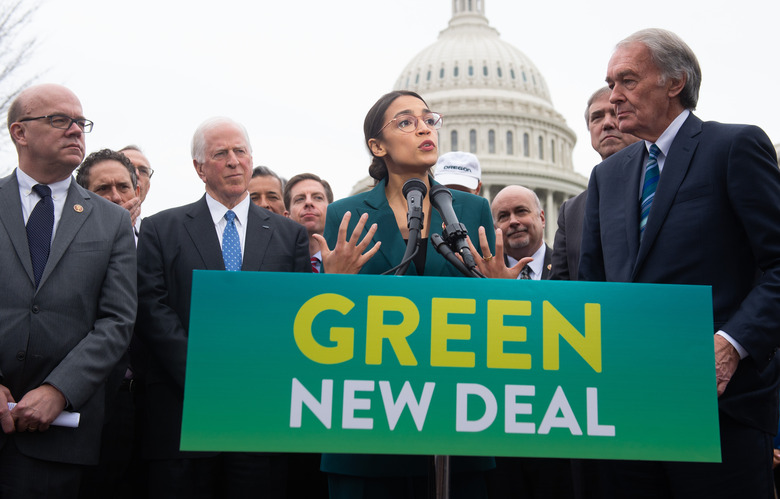Is The Green New Deal Actually Possible?
It's been a big month in politics, with Democratic presidential hopefuls like Bernie Sanders and Cory Booker kicking off their primary campaigns.
And some of the biggest political issues for 2020? Health care, inequality and, surprisingly, climate change.
Yup, scroll through any political news section and you're sure to see at least one article on the Green New Deal, a climate and economic plan popularized by congresswoman Alexandria Ocasio-Cortez.
But what exactly makes up the Green New Deal – and, more importantly, is the Green New Deal actually feasible? Read on to find out.
What's in the Green New Deal?
What's in the Green New Deal?
So you know the Green New Deal has something to do with combating climate change – but what's it really about? Overall, the Green New Deal is an eco-friendly take on the New Deal that president Franklin D. Roosevelt signed way back in the mid-1900s.
The Green New Deal involves a massive investment in clean energy and infrastructure, to help reduce U.S. dependance on carbon-based energy like coal. Overall, it aims to reduce carbon emissions, which would help slow (and hopefully stop) global warming. And, more specifically, the Green New Deal aims to lower global net carbon emissions to zero by 2050.
It's also aimed at tackling inequality, so all Americans can benefit from a new, more planet-friendly economy. For example, the Green New Deal calls for a jobs guarantee program – so any American who wants a fair-paying job can get one – as well as universal health care programs that would ensure that any American can get the health care they need.
TL;DR (Too Long; Didn't Read)
Want to read more (and not afraid of some legal-ese)? You can catch up on all the specifics of the deal [here](https://ocasio-cortez.house.gov/sites/ocasio-cortez.house.gov/files/Resolution%20on%20a%20Green%20New%20Deal.pdf).
Are the Proposals in the Green New Deal Possible?
Are the Proposals in the Green New Deal Possible?
There are two big questions surrounding the Green New Deal: Are the goals laid out in the plan possible, and can we really afford them?
The answer to the first question, at least according to Popular Science is: maybe.
Take the Green New Deal's goal for net-zero global carbon emissions by 2050. The U.S. is currently a long way off – about 80 percent of the country's fuel comes from natural gas, coal, petroleum and other carbon-based energy sources. So reducing net carbon emissions to 0 in just a few decades is a lofty goal, to say the least.
But it's not impossible, according to Mark Z. Jacobson, an environmental engineer at Stanford University: "It's technically and economically possible to [convert to renewable energy sources] by 2030," he told Popular Science. But, he notes, political factors could delay the transition to 2050 or longer.
As for whether the Green New Deal is affordable?
As for whether the Green New Deal is affordable?
Well, that depends who you ask.
It's true that the Green New Deal is expensive. For example, a "Medicare for all" universal health care plan – one of the proposed resolutions in the Green New Deal – would cost the federal government $32.6 trillion over 10 years, Business Insider reports.
But that's government spending – and it makes sense that the federal government would spend more, since the government would be providing health care to every American. But the overall amount that Americans pay for health care (once you take into account what Americans spend on insurance and out-of-pocket expenses) would go down. The plan would actually save more than $300 billion dollars a year in overall health care spending in 2031.
Transitioning the U.S. economy away from carbon could be expensive, too. One study suggests it could cost between $8.3 and $12.3 trillion dollars over 10 years to eliminate carbon emissions.
But climate change comes with a hefty price tag, too. National Geographic reports that climate change has cost the U.S. at least $240 billion a year over the past decade. And that could be a severe underestimate – last September's 76 wildfires and three major hurricanes (Irma, Michael and Florence) cost the U.S. economy $300 billion alone, according to National Geographic.
So What's the Takeaway?
So What's the Takeaway?
A proposal like the Green New Deal is an aggressive approach to tackling both climate change and inequality – and that means, yes, it will probably cost a lot of money to achieve to the goals laid out in the plan.
But not acting costs money, too – and that's not counting the humanitarian costs to climate change, like famines and loss of access to clean drinking water. As the United Nations reported last year, we have just 12 years to limit a climate disaster, which means an aggressive approach to addressing climate change is probably what the planet needs.
So, whether you're on board with the Green New Deal or not, it's probably a good thing that climate change is front and center in politics right now.
And you can join in on the conversation, too. Use our guide to contact your representatives and tell them how you want the U.S. to address climate change – whether that's by supporting the Green New Deal or something else entirely.
References
- Popular Science: The Green New Deal is more feasible than you think
- Business Insider: That study going around on Bernie Sanders' 'Medicare for All' plan comes with a big catch — the US would actually be saving money overall on healthcare
- Bloomberg: Alexandria Ocasio-Cortez's Green New Deal Could Cost $93 Trillion, Group Says
Cite This Article
MLA
Tremblay, Sylvie. "Is The Green New Deal Actually Possible?" sciencing.com, https://www.sciencing.com/is-the-green-new-deal-actually-possible-13717481/. 28 February 2019.
APA
Tremblay, Sylvie. (2019, February 28). Is The Green New Deal Actually Possible?. sciencing.com. Retrieved from https://www.sciencing.com/is-the-green-new-deal-actually-possible-13717481/
Chicago
Tremblay, Sylvie. Is The Green New Deal Actually Possible? last modified August 30, 2022. https://www.sciencing.com/is-the-green-new-deal-actually-possible-13717481/
